
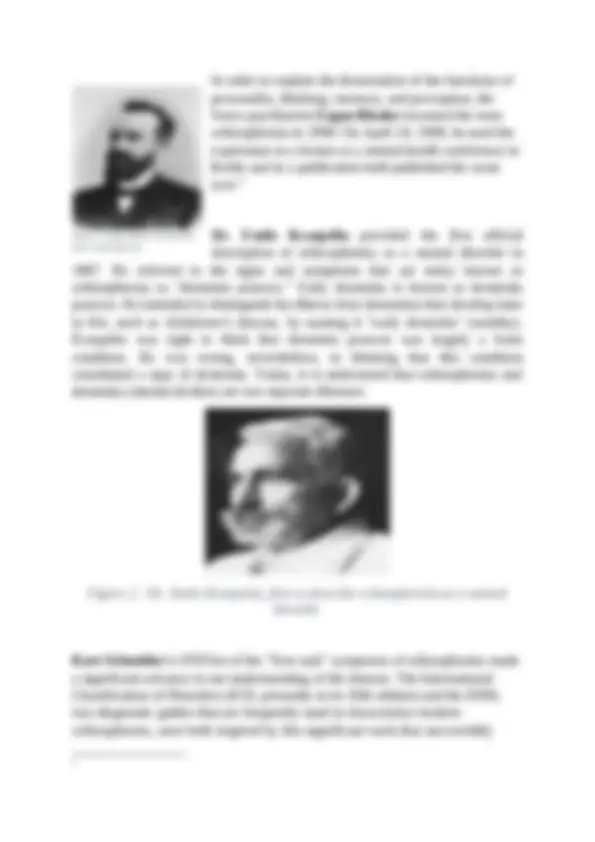
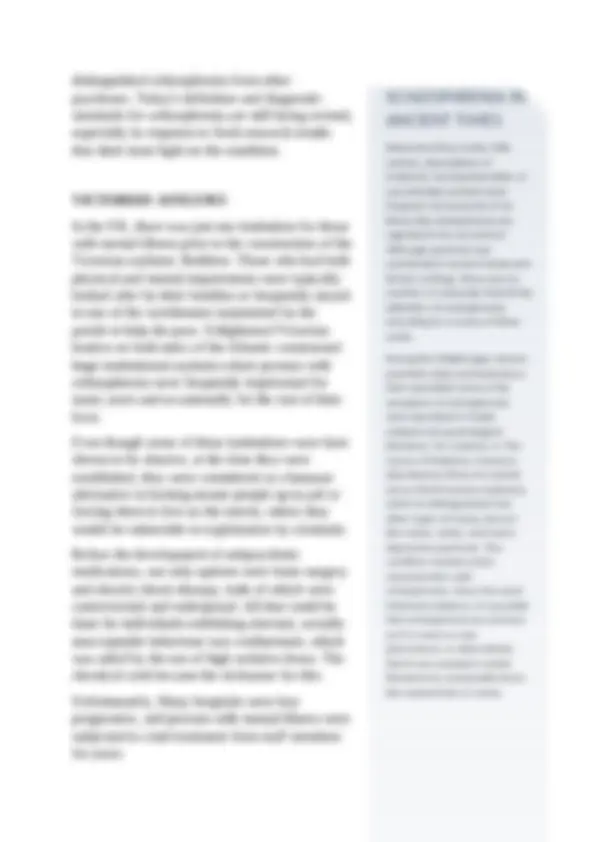
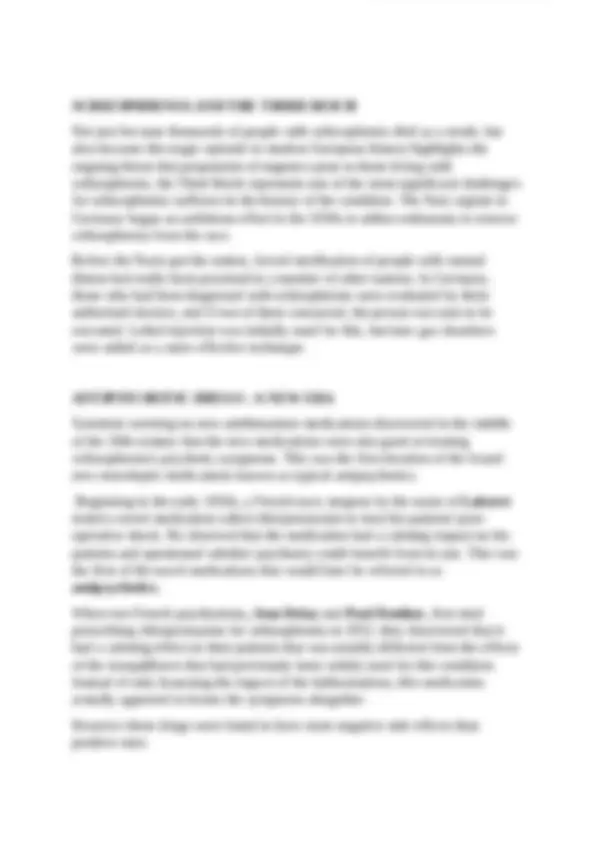
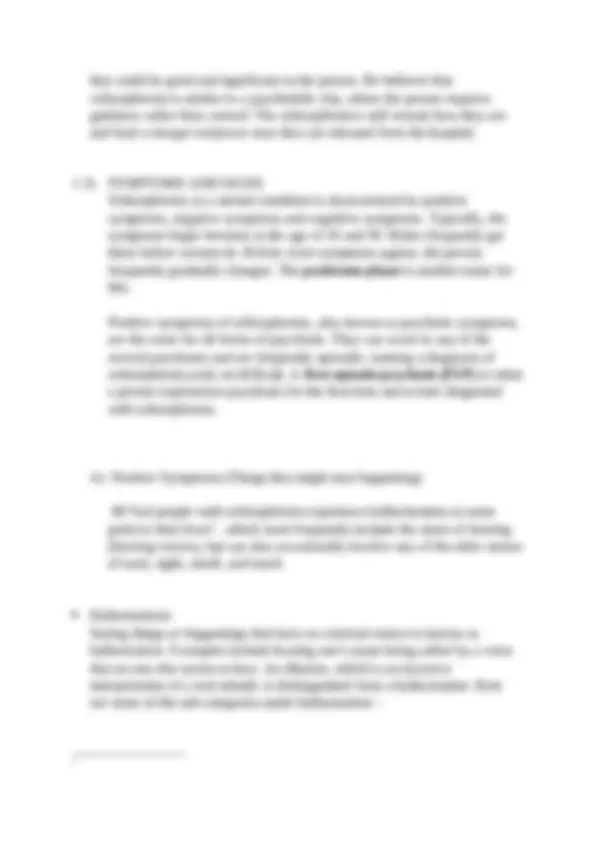
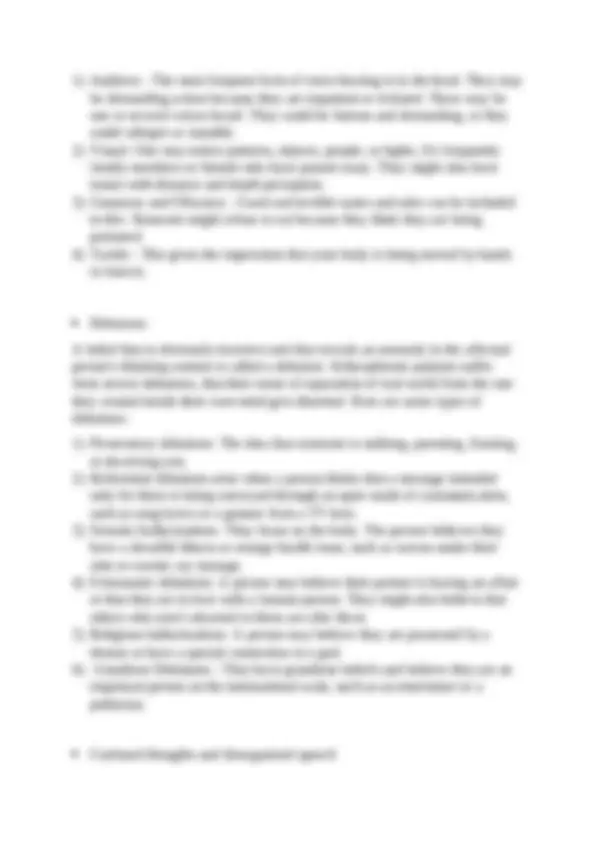
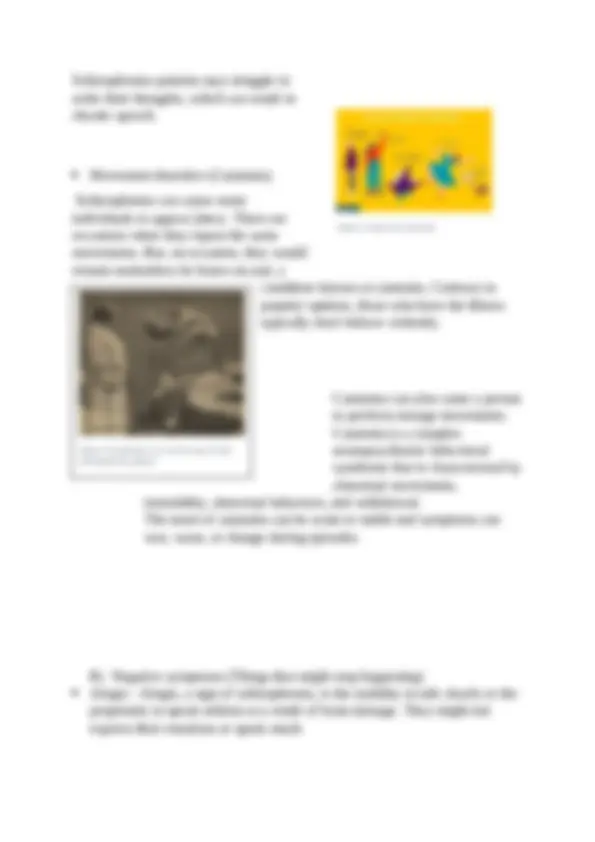
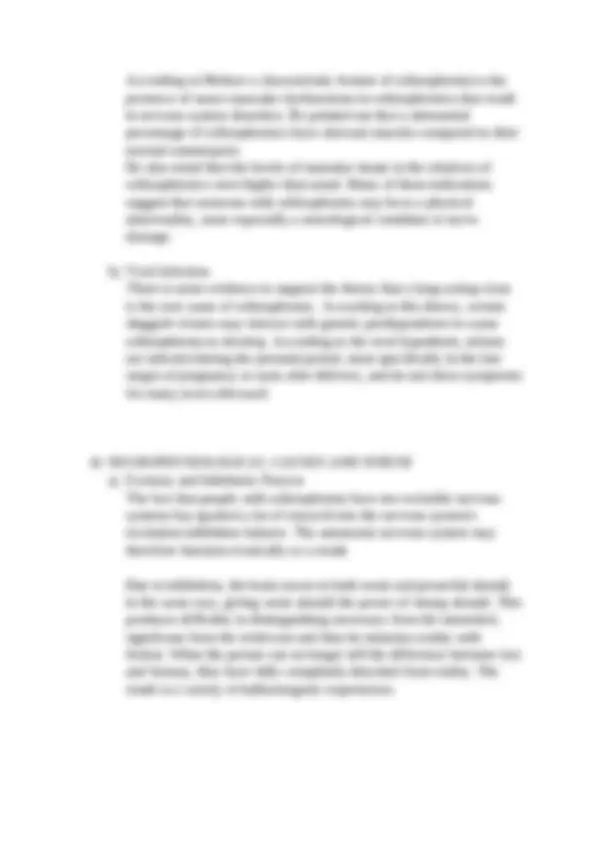
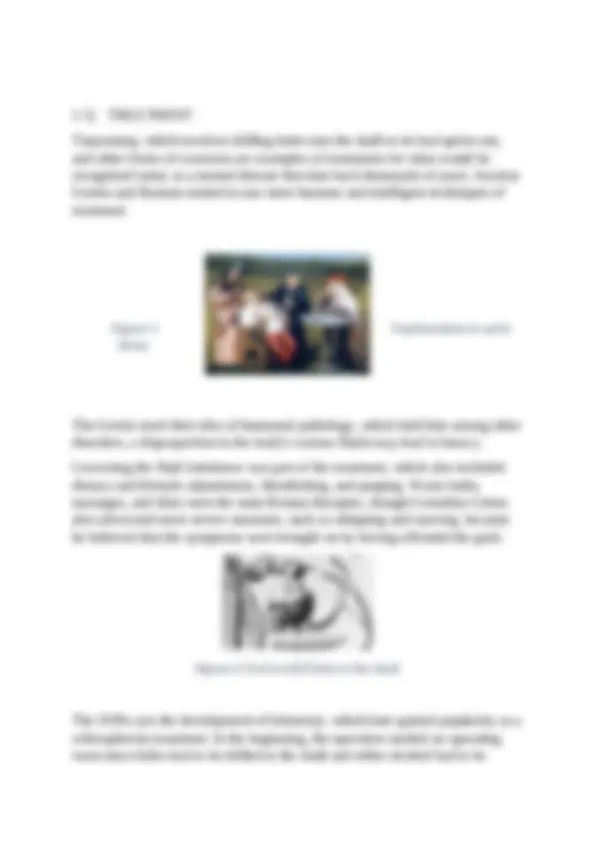
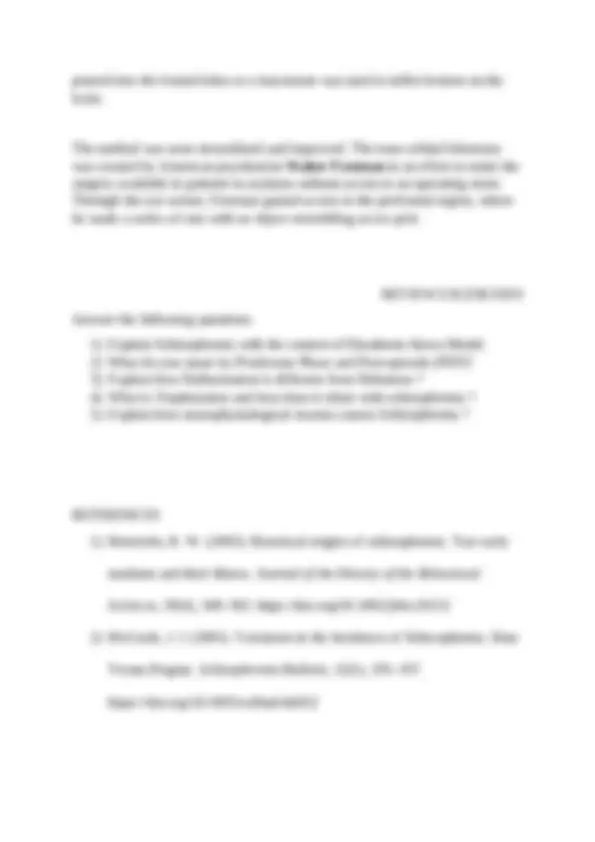


Study with the several resources on Docsity

Earn points by helping other students or get them with a premium plan


Prepare for your exams
Study with the several resources on Docsity

Earn points to download
Earn points by helping other students or get them with a premium plan
Community
Ask the community for help and clear up your study doubts
Discover the best universities in your country according to Docsity users
Free resources
Download our free guides on studying techniques, anxiety management strategies, and thesis advice from Docsity tutors
An overview of schizophrenia, including its meaning, history, theories on origins and causes, symptoms, and treatments. It discusses the history of schizophrenia from ancient times to the Third Reich, theories on its origins and causes, including the double bind theory, diathesis-stress model, neurobiological theory, and experimental theory. It also covers the symptoms of schizophrenia, including positive and negative symptoms, and the various causes, including organic, constitutional, biochemical, and neurophysiological causes. Finally, it discusses the treatments for schizophrenia, including antipsychotic drugs.
Typology: Study notes
1 / 16

This page cannot be seen from the preview
Don't miss anything!










Schizophrenia and its meaning History and origin of Victorian asylums Schizophrenia and the third Reich Antipsychotic drugs Theories on Origins and Causes of schizophrenia Double Bind Theory Diasthesis - Stress Model Neurobiological Theory Experimental Theory Symptoms of Schizophrenia Positive symptoms Negative symptoms Causes Organic cause (Biological, Hereditary factors) Constitutional Causes (Physique causes, Atypical factors) Biochemical factors (Neuro-mascular disorders, viral infection) Neurophysiological causes and stress Treatments
The disorder was first identified as having "the disconnection or splitting of the psychic functions," hence the name schizophrenia. Because of this, unfortunately, it is now widely believed that the disorder is characterized by a "split personality," which it is not. Disorganized speech or behaviour, out-of- body experiences, and diminished participation in regular tasks are all symptoms of schizophrenia. Memory loss and attention problems could also be present. Systematic reviews show That it is more common in men than in women (risk ratio 1:4:1) and is more frequent in people born in cities. 1 1.1) HISTORY OF SCHIZOPHRENIA The Chinese text The Yellow Emperor's Classic of Internal Medicine, which dates to around 1000 BC, and the Hindu Arthava Veda, which dates to around 1400 BC, both describe illnesses characterised by bizarre behaviour and a lack of self-control. The Yellow Emperor's Classic of Internal Medicine also links insanity and seizures to supernatural and demonic forces. It has also been discovered that the Greeks and Romans were generally aware of psychotic diseases. In the fourth and fifth century BC, Plato described a madness of divine origin that could spawn prophets and poets. Ancient literature frequently discusses demonic possession and paranormal powers as the root of mental disease. 1 Greek word skhizen Modern latin ‘SCHIZOPHRENIA’ Greek word phren
distinguished schizophrenia from other psychoses. Today's definition and diagnostic standards for schizophrenia are still being revised, especially in response to fresh research results that shed more light on the condition. VICTORIAN ASYLUMS In the UK, there was just one institution for those with mental illness prior to the construction of the Victorian asylums: Bethlem. Those who had both physical and mental impairments were typically looked after by their families or frequently stayed in one of the workhouses maintained by the parish to help the poor. Enlightened Victorian leaders on both sides of the Atlantic constructed huge institutional asylums where persons with schizophrenia were frequently imprisoned for many years and occasionally for the rest of their lives. Even though some of these institutions were later shown to be abusive, at the time they were established, they were considered as a humane alternative to locking insane people up in jail or forcing them to live on the streets, where they would be vulnerable to exploitation by criminals. Before the development of antipsychotic medications, our only options were brain surgery and electric shock therapy, both of which were controversial and widespread. All that could be done for individuals exhibiting aberrant, socially unacceptable behaviour was confinement, which was aided by the use of high sedative doses. The chemical cosh became the nickname for this. Unfortunately, Many hospitals were less progressive, and persons with mental illness were subjected to cruel treatment from staff members for years.
(Heinrichs) Prior to the 19th century, descriptions of irrational, incomprehensible, or uncontrolled conduct were frequent, but accounts of an illness like schizophrenia are regarded to be uncommon. Although psychosis was mentioned in ancient Greek and Roman writings, there was no mention of a disorder that fit the definition of schizophrenia, according to a survey of these works. During the Middle Ages, bizarre psychotic ideas and behaviours that resembled some of the symptoms of schizophrenia were described in Arabic medical and psychological literature. For instance, in The Canon of Medicine, Avicenna described an illness he named Junun Mufrit (severe madness), which he distinguished from other types of lunacy (Junun) like mania, rabies, and manic depressive psychosis. This condition shared certain characteristics with schizophrenia. Given the scant historical evidence, it is possible that schizophrenia (as common as it is now) is a new phenomena, or alternatively that it was masked in earlier literature by comparable terms like melancholia or mania.
Not just because thousands of people with schizophrenia died as a result, but also because this tragic episode in modern European history highlights the ongoing threat that proponents of eugenics pose to those living with schizophrenia, the Third Reich represents one of the most significant challenges for schizophrenia sufferers in the history of the condition. The Nazi regime in Germany began an ambitious effort in the 1930s to utilise euthanasia to remove schizophrenia from the race. Before the Nazis got the notion, forced sterilisation of people with mental illness had really been practised in a number of other nations. In Germany, those who had been diagnosed with schizophrenia were evaluated by three authorised doctors, and if two of them concurred, the person was sent to be executed. Lethal injection was initially used for this, but later gas chambers were added as a more effective technique. ANTIPSYCHOTIC DRUGS : A NEW ERA Scientists working on new antihistamine medications discovered in the middle of the 20th century that the new medications were also good at treating schizophrenia's psychotic symptoms. This was the first iteration of the brand- new neuroleptic medications known as typical antipsychotics. Beginning in the early 1950s, a French navy surgeon by the name of Laboret tested a novel medication called chlorpromazine to treat his patients' post- operative shock. He observed that the medication had a calming impact on his patients and questioned whether psychiatry could benefit from its use. This was the first of the novel medications that would later be referred to as antipsychotics. When two French psychiatrists , Jean Delay and Paul Deniker, first tried prescribing chlorpromazine for schizophrenia in 1952, they discovered that it had a calming effect on their patients that was notably different from the effects of the tranquillizers that had previously been widely used for this condition. Instead of only lessening the impact of the hallucinations, this medication actually appeared to lessen the symptoms altogether. However these drugs were found to have more negative side effects than positive ones.
1) “Double bind” Theory The ideas explaining its origin also advanced along with the classification of schizophrenia. In the middle of the 1950s , Gregory Bateson and colleagues proposed the "double bind" theory. According to this hypothesis, some types of poor parenting, specifically when parents explicitly stated one thing while simultaneously sending their children implicit messages with the exact opposite meaning, were to blame for the development of schizophrenia. 2) Diasthesis-stress model The diathesis-stress theories of schizophrenia imply that people have vulnerabilities and predispositions to schizophrenia (diatheses). Some people are more susceptible to these factors than others for a variety of genetic, biological, and experiential reasons. The disorder cannot be brought on by a predisposition to schizophrenia alone. Instead, the interaction between a person's vulnerabilities and stressors in their lives is what causes the illness to manifest. The greater an individual's predisposition to acquire schizophrenia, the less stress is required to set off a psychotic episode and cause the illness. In contrast, if there is a lower propensity to develop schizophrenia, more stress is needed to bring on the illness. 3) Neuro-biological Theory According to neurobiological theory, neurotransmitter dysregulation, such as an excess of dopamine, a decrease in glutamate levels in the cerebrospinal fluid, a rise in gamma aminobutyric acid (GABA) production in the prefrontal cortex, or a decrease in serotonin levels, causes schizophrenia. Antipsychotics are essential in controlling these abnormal neurotransmitter levels. Antipsychotics are useful in lowering both positive and negative symptoms, including delusions and social withdrawal. They also help patients express more emotion. 4) Experimental Theory By Ronald Laing Believes that schizophrenia is a name for a certain category of troublesome experiences and behaviours rather than a medical condition. The experimental theory holds that a particular behaviour is first labelled as schizophrenia by the family as opposed to being accepted as an experience
that could be good and significant to the person. He believes that schizophrenia is similar to a psychedelic trip, where the person requires guidance rather than control. The schizophrenics will remain how they are and lead a meagre existence once they are released from the hospital. 1.3) SYMPTOMS AND SIGNS Schizophrenia as a mental condition is characterized by positive symptoms, negative symptoms and cognitive symptoms. Typically, the symptoms begin between at the age of 16 and 30. Males frequently get them before women do. Before overt symptoms appear, the person frequently gradually changes. The prodrome phase is another name for this. Positive symptoms of schizophrenia, also known as psychotic symptoms, are the same for all forms of psychosis. They can occur in any of the several psychoses and are frequently sporadic, making a diagnosis of schizophrenia early on difficult. A first-episode psychosis (FEP) is when a person experiences psychosis for the first time and is later diagnosed with schizophrenia. A) Positive Symptoms (Things that might start happening) 80 %of people with schizophrenia experience hallucinations at some point in their lives 3 , which most frequently include the sense of hearing (hearing voices), but can also occasionally involve any of the other senses of taste, sight, smell, and touch. Hallucinations Seeing things or happenings that have no external source is known as hallucination. Examples include hearing one's name being called by a voice that no one else seems to hear. An illusion, which is an incorrect interpretation of a real stimuli, is distinguished from a hallucination. Here are some of the sub-categories under hallucination – 3
Schizophrenia patients may struggle to order their thoughts, which can result in chaotic speech. Movement disorders (Catatonia) Schizophrenia can cause some individuals to appear jittery. There are occasions when they repeat the same movements. But, on occasion, they would remain motionless for hours on end, a condition known as catatonia. Contrary to popular opinion, those who have the illness typically don't behave violently. Catatonia can also cause a person to perform strange movements. Catatonia is a complex neuropsychiatric behavioral syndrome that is characterized by abnormal movements, immobility, abnormal behaviors, and withdrawal. The onset of catatonia can be acute or subtle and symptoms can wax, wane, or change during episodes B) Negative symptoms (Things that might stop happening) Alogia - Alogia, a sign of schizophrenia, is the inability to talk clearly or the propensity to speak seldom as a result of brain damage. They might not express their emotions or speak much. Figure 4 Types of catatonia Figure 3 Catatonia as it can be seen in this schizophrenic patient
Flattening – A person with schizophrenia may appear to be suffering from the worst case of the emotions. They sometimes have a flat, emotionless voice when speaking. They might not respond to discussions or events around them with their typical smile or facial expression. This is what a doctor could refer to affective flattening. Withdrawal - This could involve ceasing to make arrangements with people or isolating oneself. Chatting to them can be like arguing with a stubborn person; you have to fight hard to get an answer. Health professionals refer to condition as apathy. Avolition - No execution of tasks. Schizophrenia patients have problems sticking to a schedule or completing tasks. Sometimes they are completely unable to begin. 1.4) CAUSES OF SCHIZOPHRENIA
According to Meltzer a characteristic feature of schizophrenia is the presence of neuro muscular dysfunctions in schizophrenics that result in nervous system disorders. He pointed out that a substantial percentage of schizophrenics have aberrant muscles compared to their normal counterparts. He also noted that the levels of muscular tissue in the relatives of schizophrenics were higher than usual. Many of these indications suggest that someone with schizophrenia may have a physical abnormality, more especially a neurological condition or nerve damage. b) Viral Infection There is some evidence to support the theory that a long-acting virus is the root cause of schizophrenia. According to this theory, certain sluggish viruses may interact with genetic predispositions to cause schizophrenia to develop. According to the viral hypothesis, infants are infected during the prenatal period, most specifically in the late stages of pregnancy or soon after delivery, and do not show symptoms for many years afterward.
Trepanning, which involves drilling holes into the skull to let bad spirits out, and other forms of exorcism are examples of treatments for what would be recognized today as a mental disease that date back thousands of years. Ancient Greeks and Romans tended to use more humane and intelligent techniques of treatment. Figure 5 Trephenation in early times The Greeks used their idea of humoural pathology, which held that among other disorders, a disproportion in the body's various fluids may lead to lunacy. Correcting the fluid imbalance was part of the treatment, which also included dietary and lifestyle adjustments, bloodletting, and purging. Warm baths, massages, and diets were the main Roman therapies, though Cornelius Celsus also advocated more severe measures, such as whipping and starving, because he believed that the symptoms were brought on by having offended the gods. Figure 6 Tool to drill hole in the skull The 1930s saw the development of lobotomy, which later gained popularity as a schizophrenia treatment. In the beginning, the operation needed an operating room since holes had to be drilled in the skull and either alcohol had to be